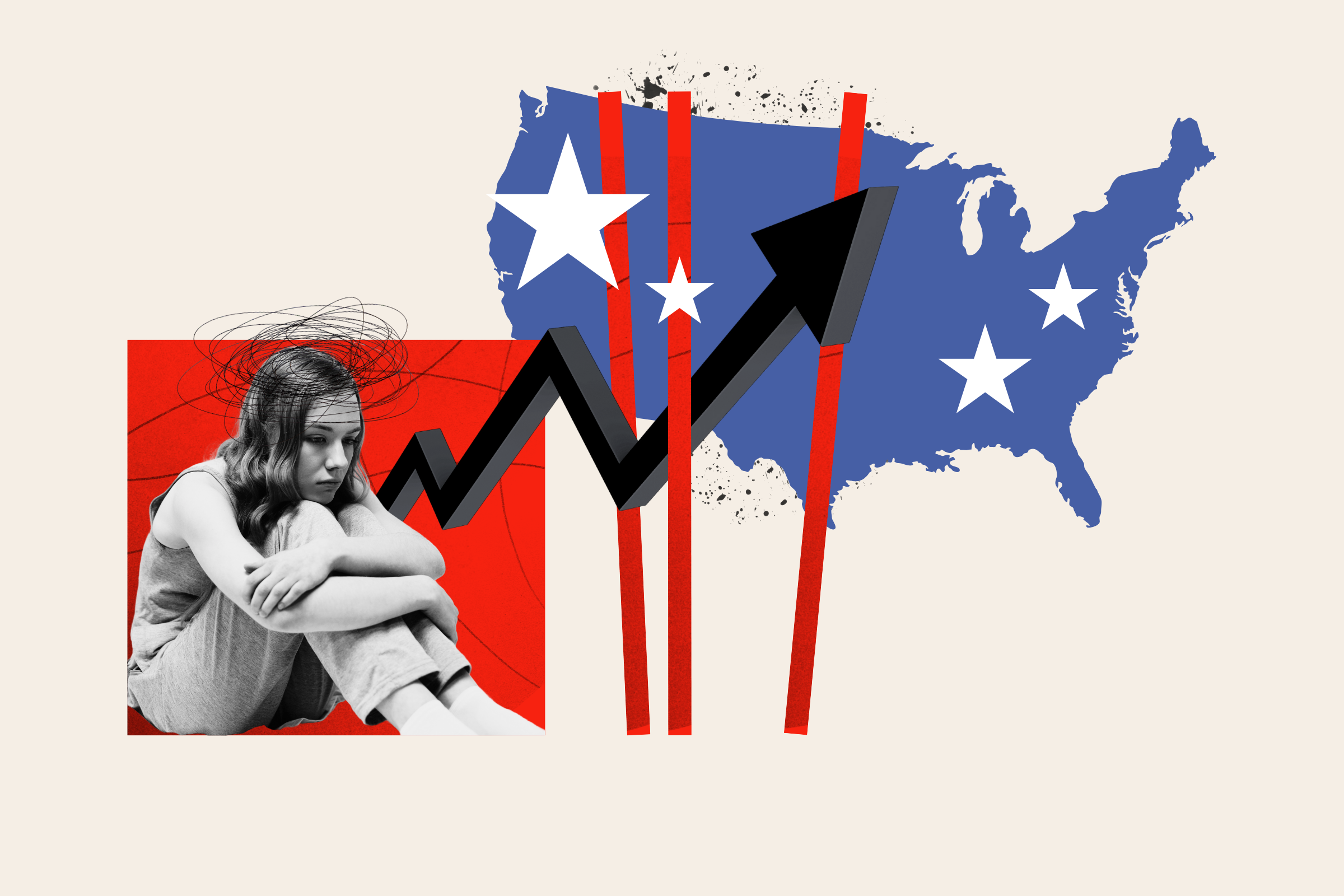
Depression remains an ongoing problem in the U.S. as historically high rates persist, polling company Gallup reveals.
The reported percentage of U.S. adults suffering or receiving treatment for depression has been higher than 18 percent for the past two years. A decade ago, in 2015, the number was just over 10 percent.
“The increase is alarming, and it is important that we keep an open mind and explore all possible causes for the rapid, and apparently sustained, rise in depression rates over the past decade,” Dr. Gerard Sanacora, a professor of psychiatry, director of Yale Depression Research Program and co-director of Yale New Haven Hospital Interventional Psychiatry Service at Yale University, told Newsweek.
Why It Matters
Depression is a common mental health condition that can affect how a person thinks, sleeps, eats and acts, and often causes a persistent feeling of sadness and loss of interest in previously enjoyed things, but is different to sadness or grief.
It affects millions of Americans, and recent data from the World Health Organization (WHO) indicated that as many as 1 billion people worldwide are living with mental health disorders such as depression and anxiety.
There are many different types and severities of depression, and in severe cases, it can lead to self-harm or death by suicide. Tens of thousands of Americans take their own lives each year, highlighting the crucial importance of mental health treatment and support.
Risk Factors For Depression
While depression can affect anyone, both children and adults, there are some known risk factors, Sanacora said. These include “genetics, age, gender, and decline in general health.”
“It is possible that some change in general health, for example related to long COVID or increased levels of obesity and metabolic disorders could be contributing to the increase,” he added, noting though that the impact of these risk factors “probably has not changed dramatically throughout the population in recent years.”
Other major risk factors known to be associated with depression “are more related to stressful life events, substance use, and social isolation,” he said.
The Impact of the COVID-19 Pandemic
The turning point of the recent increase in America’s depression rates occurred during the COVID-19 pandemic, in 2020, according to Gallup’s data.
In 2019, the percentage of U.S. adults that reported having depression in Gallup’s survey, which is part of the ongoing Gallup National Health and Well-Being Index, was 12.5 percent.
The questions respondents were asked included: “Has a doctor or nurse ever told you that you have depression?” and if yes, “Do you currently have or are you currently being treated for depression?”
From 2019 onward, rates of depression soared, going from 13.8 percent in 2020 to 17.8 percent in 2023.
As depression rates continued to rise in the wake of the pandemic, it suggests that “the pandemic was more of a tipping point than a blip,” Dr. David Mischoulon, director of the Depression Clinical and Research Program at Massachusetts General Hospital and professor of psychiatry at Harvard Medical School, told Newsweek.
This is likely because the COVID-19 pandemic “led to major changes in the way our society functions, resulting in various forms of physiological and psychological stress as well as marked social isolation,” Sanacora said.
These changes included the lockdown, mobility restrictions, job loss, housing and food insecurity, and many others, Mischoulon said, which “all drove increases in depression and have not resolved for many people in the post-pandemic era.”
He said that the adoption of hybrid or fully remote models of work has led to social isolation remaining “an issue for many.”
Also, “many jobs that were lost during the pandemic have not returned,” he added. “The problems that emerged during the pandemic have not gone away completely and have contributed to increases in depression.”
A new influencing factor, brought by the COVID-19 pandemic, is that now “many people who had COVID are still dealing with after effects of the illness, e.g. long hauler syndrome, which may contribute to depression,” Mischoulon said.
While the pandemic had a global impact on health and well-being, these changes “likely disproportionally affected adolescents and younger adults in addition to those from lower socio-economic backgrounds,” Sanacora said.
According to Gallup’s data, reports of depression have risen from 22.1 percent in 2017 to to 35.1 percent this year in households earning below $24,000 a year, a 13 point increase in eight years.
The same trend is identifiable among adults below the age of 30, depression rates doubling from 13 percent in 2017 to 26.7 percent in 2025.
Why Depression Is Higher Among Young People
While the COVID-19 pandemic was a marked turning point in the acceleration of depression in the country, “depression in young people was already on the rise prior to the pandemic and was accelerated by it,” Mischoulon said.
This is down to many factors, including the rise of social media and screen time among young people, he said.
Also, “the developmental challenges faced by adolescents and young adulthood have also been complicated by the current societal, economic, and political instability,” he said.
“The increasingly polarized political environment in the U.S. has also contributed to insecurity, interpersonal conflict, and family instability among other things,” he added.
Another influencing factor could be “changes in substance use patterns,” Sanacora said.
While data appears to indicate there has been a recent decline in the proportion of young people using substances, there is also suggestion that those who do use substances are reporting “intensified consumption patterns with rising levels of disorder,” one 2024 study found.
Psychologists have been pushing different approaches of tackling substance misuse in young people in recent years, and the issue remains a public health concern.
Other Factors Influencing Depression
Alongside financial stress, especially in young adults and lower-income individuals, as well as student debt, rent and food insecurity, loneliness levels have also “gone up since the start of the pandemic,” Mischoulon said.
Gallup research has found a strong link between depression and loneliness, and while pandemic-era spikes in loneliness dropped between 2022 and 2023, there has since been an uptick.
In 2020 and 2021, there were points where 25 percent of U.S. adults said they had felt lonely “a lot of the day yesterday.” While this dropped to lows of 17 percent in 2022 and 2023, levels have crept up to 21 percent in 2025.
“More openness about mental health issues and improved sophistication in the mental health field has resulted in more people seeking help and an increase in rates of diagnoses,” Mischoulon said, adding this may not always “reflect an increase in the condition itself, just in its identification.”
For those with lower-income, “educational limitations, unemployment, homelessness, and isolation historically have increased the risk of mental distress and suicidality,” he said.
Also, “financial insecurity, housing instability, food scarcity, and limited health care access have been a growing issue since the pandemic, and all contribute to depression,” he added.
Mischoulon also said that “depression can result in unemployment or underemployment, which in turn heightens financial stress, creating a vicious circle.”
Overall, while the increase in depression rates in the U.S. may in part be influenced by the rise in attention paid to mental health issues in recent years, “there does also appear to be a true increase in the number of people experiencing the symptoms of depression,” Sanacora said.
Full Interview Below
Newsweek’s interview with Dr. David Mischoulon, director of the Depression Clinical and Research Program at Massachusetts General Hospital and professor of psychiatry at Harvard Medical School.
Q1: What factors have led to the rapid increase in the rates of depression in the U. S.?
“Depression rates have almost doubled in the past decade, due to many factors. Financial stress, especially on young adults and lower-income individuals, such as, student debt, rent and food insecurity are contributors. Also, loneliness levels have gone up since the start of the pandemic. More openness about mental health issues and improved sophistication in the mental health field has resulted in more people seeking help and an increase in rates of diagnoses—that may not always reflect an increase in the condition itself, just in its identification. Social media use has been associated with increased depressive symptoms, cyberbullying, sleep disturbances, [fear of missing out (FOMO)], and social comparison. The increasingly polarized political environment in the U.S. has also contributed to insecurity, interpersonal conflict, and family instability among other things.”
Q2: Why has the COVID pandemic had such a prolonged impact on depression rates? It seems from the data this was the turning point—but why have rates continued to go up in the years after the pandemic as well?
“The pandemic was more of a tipping point than a blip. The lockdown, mobility restrictions, job loss, housing and food insecurity all drove increases in depression and have not resolved for many people in the post-pandemic era. For example, with the adoption of hybrid or 100 percent remote models of work, social isolation remains an issue for many. Many jobs that were lost during the pandemic have not returned. Many people who had COVID are still dealing with aftereffects of the illness, such as long hauler syndrome, which may contribute to depression. Other changes in the job market and general lifestyle also contribute to isolation and job insecurity. The problems that emerged during the pandemic have not gone away completely and have contributed to increases in depression.”
Q3: Why do you think this increase in depression is largely among those under the age of 30?
“Depression in young people was already on the rise prior to the pandemic and was accelerated by it. Social media and screen time among younger people have contributed to depression. The developmental challenges faced by adolescents and young adulthood have also been complicated by the current societal, economic, and political instability. An entire generation of teens and young adults came into a world very different from the one they grew up in and expected to have as they entered adulthood. It’s sort of a culture shock, but the concrete problems they face are very real.”
Q4: How does socio-economic background affect depression rates, and why do those with lower income tend to have higher rates of depression as the data shows?
“The stress level associated with educational limitations, unemployment, homelessness, and isolation historically have increased the risk of mental distress and suicidality. Lower income households have depression rates that have increased over the past few years. Financial insecurity, housing instability, food scarcity, and limited health care access have been a growing issue since the pandemic, and all contribute to depression. Depression can result in unemployment or underemployment, which in turn heightens financial stress, creating a vicious circle.”



